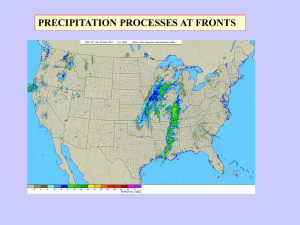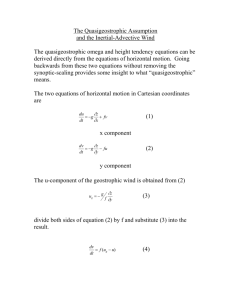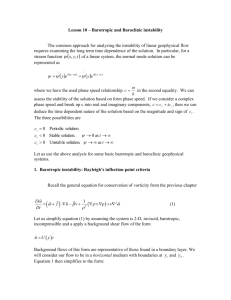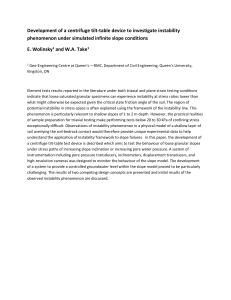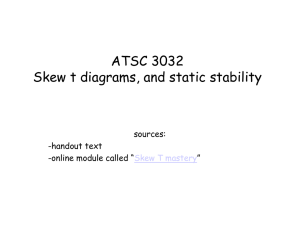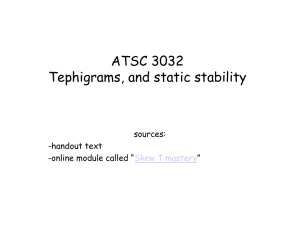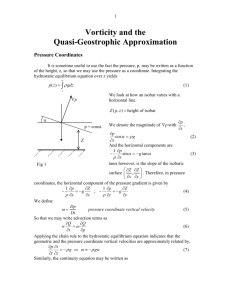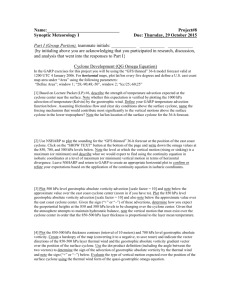CSI
advertisement
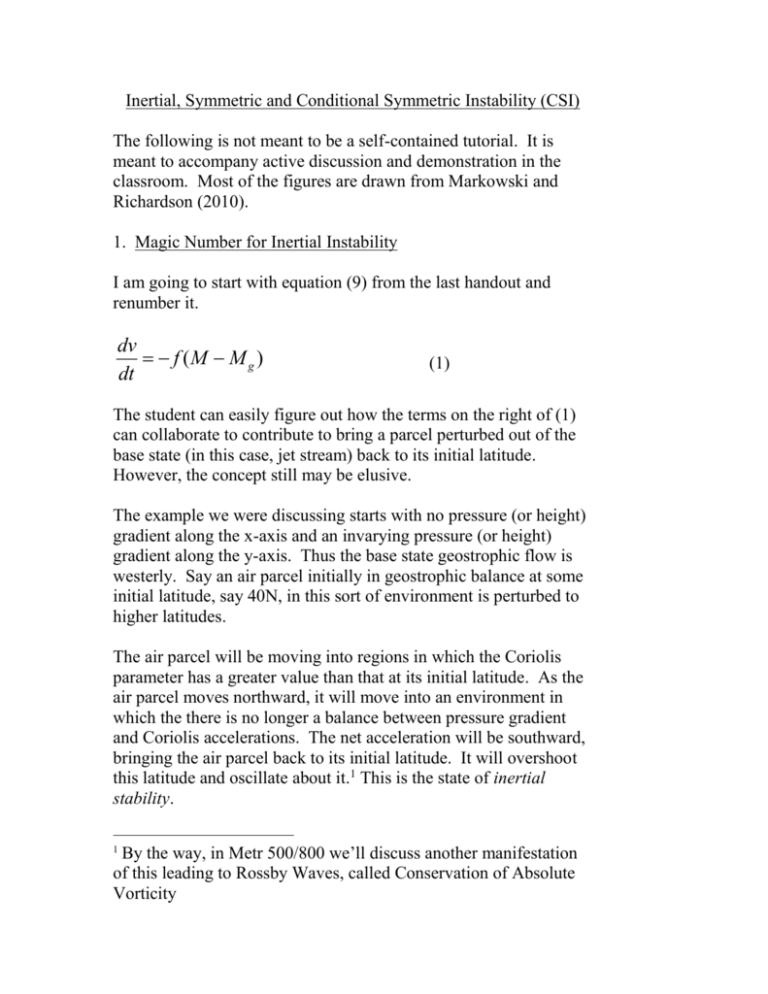
Inertial, Symmetric and Conditional Symmetric Instability (CSI) The following is not meant to be a self-contained tutorial. It is meant to accompany active discussion and demonstration in the classroom. Most of the figures are drawn from Markowski and Richardson (2010). 1. Magic Number for Inertial Instability I am going to start with equation (9) from the last handout and renumber it. dv = - f (M - M g ) dt (1) The student can easily figure out how the terms on the right of (1) can collaborate to contribute to bring a parcel perturbed out of the base state (in this case, jet stream) back to its initial latitude. However, the concept still may be elusive. The example we were discussing starts with no pressure (or height) gradient along the x-axis and an invarying pressure (or height) gradient along the y-axis. Thus the base state geostrophic flow is westerly. Say an air parcel initially in geostrophic balance at some initial latitude, say 40N, in this sort of environment is perturbed to higher latitudes. The air parcel will be moving into regions in which the Coriolis parameter has a greater value than that at its initial latitude. As the air parcel moves northward, it will move into an environment in which the there is no longer a balance between pressure gradient and Coriolis accelerations. The net acceleration will be southward, bringing the air parcel back to its initial latitude. It will overshoot this latitude and oscillate about it.1 This is the state of inertial stability. By the way, in Metr 500/800 we’ll discuss another manifestation of this leading to Rossby Waves, called Conservation of Absolute Vorticity 1 But now, let’s think about how we can get the air parcel to continue to be accelerated northward out of the current. To do that, remember that equation (1) has to return a positive result. dv >0 dt (2) Putting (2) into (1) we see that this can only occur for situations in which the term in parentheses in equation (1) returns a negative result. This occurs when the air parcel perturbed northward out of the flow, conserving its M, moves into regions in which the value of the ambient geostrophic momentum is greater than M. That can only occur if Mg increases northward, or (M g f - M gi ) > 0 (3a) or, to put it in a way that fits the example we are considering ¶M g >0 ¶y (3b) Recall that the definition of the geostrophic momentum, Mg, is ug - fy = M g (4) Inserting (4) into (3b) and making the so-called Beta Plane approximation (which is that the north-south variation of f is so small across the middle latitudes that it can be approximated by a constant value of f), the left side of (3b) becomes ¶M g ¶ug = -f ¶y ¶y (5) Now, recall the definition of geostrophic relative vorticity 2 ¶vg ¶ug zg = ¶x ¶y (6) Since, in the example we are assuming that the base state flow is geostrophic and purely westerly, then equation (6) becomes zg = - ¶ug ¶y (7) The absolute vorticity of the geostrophic wind is hg = z g + f (8) Put (7) into (8) and that result into (5) to get ¶M g = -hg ¶y (9) Equation (9) states that the condition for inertial instability is that the absolute vorticity is negative. In other words, the geostrophic momentum increases northward in regions in which the absolute geostrophic vorticity is negative. This is something that can be easily diagnosed on a weather map. A real case in which precipitation bands developed in areas of negative absolute geostrophic vorticity is provided in Fig. 1. 3 Figure 1. Rapid Update Cycle initialization of 600 mb heights (dm). Negative absolute geostrophic voriticy is shown as dashed red contours at intervals of -3 X 10-5 s-1 and orange areas show regions of negative potential vorticity. Thus, the orange and red areas denote regions of inertial instability. The red areas were generally coextensive with bands of precipitation observed on this day and time. (Source: Figure 3.6, Markowski and Richardson 2010) 2. More on Symmetric Instability In the last handout, we discussed how a combination of static instability and inertial stability could produce a situation in which a slantwise deflection of the air parcel out of the base state would produce a situation in which the parcel continues to be accelerated (rather than returning to its initial position in an oscillation). Recall that the static stability can be estimated by the slope and vertical packing of the isentropes and the inertial stability can be estimated by the packing and slope of the lines of constant geostrophic 4 momentum. That illustration (Fig. 3.9) of the procecure in the last handout gave us our first overview of symmetric instability. Here’s a closer look at that same diagram but labeled Fig. 2 here. Figure 2. Zoomed in view of Fig. 3.9 in last handout. (Source: Figure 3.10, Markowski and Richardson 2010) Note that for the case of intertial stability a parcel would be laterally moved along the line segment ∆y and would find itself in an environment of lesser geostrophic momentum. The parcel would therefore oscillate back to its initial position. But, if one considers the impact of static stability, one notes that along that same transect, this air parcel enters a region in which its potential temperature is greater than that of the environmental air. Hence, the air parcel will also be accelerated along the path shown by ∆z. The net path is slantwise, as shown by the line segment ∆s. The orange area encompasses the region in which a combination of paths/vectors yields a northward acceleration of the air parcel. Hence, there is a range of values of potential temperature and geostrophic momentum that would yield a symmetrically unstable set of conditions for that air parcel. Thus, possible exponential growth of the slantwise velocity would occur along the paths extrapolated into that orange area. The “release” of symmetric instability is termed slantwise convection. 5 3. Conditional Symmetric Instability The real atmosphere contains many situations in which upright convection occurs in the presence of a Level of Free Convection (LFC). As you know, such a situation is termed conditionally unstable. Conditional (upright or gravitational or static) instability, like absolute instabilty, can also be assessed from cross sections. However, whereas cross-sections of potential temperature can be used to assess absolute instability, cross sections of equivalent potential temperature can be used to assess layers of conditional instability. Equivalent potential temperature includes the effects of the latent heat released, thus raising the potential temperature of ascending air parcels. Areas on cross-sections in which equivalent potential temperature decreases with height are associated with layers that are conditionally unstable. In general, surfaces of constant equivalent potential temperature have steeper slopes than isentropes. Isentropes of equivalent potential temperature can be used to assess moist symmetric instability. This is known as “conditional symmetric instability” (CSI) because the “condition” is that somewhere along its path the air parcel encounters an LCL (and becomes saturated) and, then, eventually encounters something analagous to an LFC in a slantwise fashion. The rest of the discussion uses this as a conceptual underpinning of CSI. Be aware that some controversy exists whether this explanation is best, rather than an approach that utilizes moist adiabatic processes to develop an instability criterion analgous to that for inertial instability, as given in Equation (9). Those approaches use a variable called Moist Potential Geostrophic Vorticity (MPVg) by evaluating CSI on the basis of the relationship of the slope of MPVg contours to the slope of contours of equivalent potential temperature. For us, this dispute is interesting but a sidelight. The instability criterion for conditional symmetric instability that can be visualized easily on charts centers on the slopes of the 6 equivalent potential temperature and geostrophic momentum contours. The criterion is given in Equation (10). æ Dz ö æ Dz ö > çè Dy ÷ø çè Dy ÷ø qe Mg (10) Equation (10) states that regions in which the slope of the contours of equivalent potential temperature exceeds the slope of the contours of geostrophic momentum are conditionally symmetrically unstable. Note that when contours of equivalent potential temperature slope upwards, the air column bounded by them has a higher mean equivalent potential temperature and, hence, larger values of thickness. Thus, in visualizing precipitation bands, one should find that the bands are tangent to thickness contours. Some of the characteristics of the precipitation bands related to release (slantwise convection) of CSI are summarized in Table 3.1. (Source: Table 3.1, Markowski and Richardson, 2010). Please note that one must be certain that the atmosphere is neither absolutely unstable nor interially unstable in these regions, because by definition static instability and/or intertial instability takes “precedence” (is released) first. This simply means that if the atmosphere is inertially unstable, the static stabilty is immaterial and a horizontal wave will develop. Likewise, if the atmosphere is absolutely unstable, the intertial instability is immaterial and upright convection will dominate. 7 A situation in which the instability critierion is met is illustrated in Figure 3. This shows a real case of mesoscale bands, parallel to thickness contours (seen on Fig. 4) in the warm advection area northwest of a surface warm front. The cross-section given is along the blue line stretching from DDC to MLC on Fig 3a. Figure 3. (a) Vance Air Force Base (VNX) 88-D reflectivity at 1658 UTC 30 November 2006. (b) A vertical cross section tnormal to hte bands at 1700 UTC from roughly Dodge City to Kansas City. Grey stippled areas on (b) indicate regions in which the equivalent potential temperature contours have steeper slopes than contours of geostrophic momentum. Grey shaded region is aproximately neutral or slightly unstable with respect to CSI. (Source: Figure 3.11, Markowski and Richardson 2010). 8 Regions analagous to areas of CAPE can be approximated by the area bounded by the lines of constant geostrophic momentum and the contours of equivalent potential temperature (shaded in grey on Fig. 3b). To visualize this, recall that parcels actually move along equivalent potential temperature contours. Where those contours are steeper than the geostrophic momentum contours, the area bounded is analagous the areas meteorologists shade (in red) on conventional sounding analyses to indicate positive areas on soundings. Figure 4. NCEP Reanalysis of 1000-500 mb Thickness (dm) at 1200 UTC 30 November 2006. Also, the maximum updraft speed in the slanted direction can be estimated for CSI areas using the slantwise convective available potential energy (SCAPE), which is basically the integration of buoyancy in the area in which the equivalent potential temperature contours are steeper than geostrophic momentum contours. Vertical velocities within the updrafts of CSI areas are on the order of 1 m s-1, compared to a few cm s-1 on the synoptic scale and 10 m s-1 in the buoyant updrafts of strong thunderstorms. 4. Reference Markowski, P. And Y. Richardson, 2010: Mesoscale meteorology in midlatitudes. Wiley-Blackwell, 2010. ISBN: 978-0470742136. 430 pp. 9
